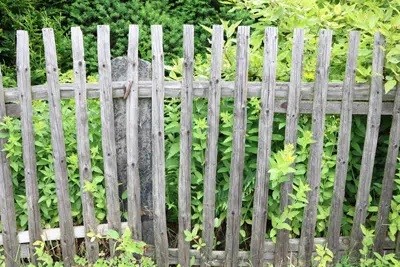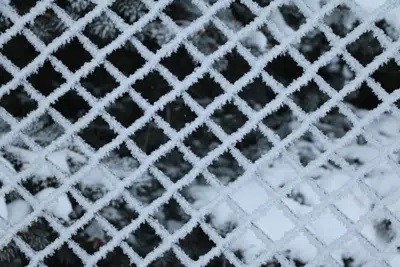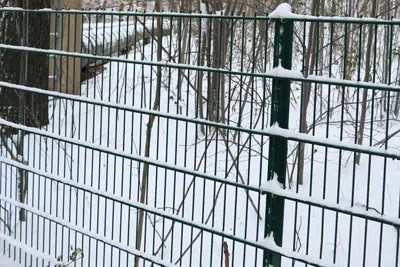Last updated on October 23rd, 2023 at 08:33 pm
Before purchasing a fence, you should first consider whether it should be exclusively functional, whether only the visual aspect is important or whether both play a role. When choosing the material, the price is often a decisive criterion, because the price differences can sometimes already be considerable.
However, the quality should not be disregarded, because as is well known, quality also has its price. However, this does not mean that quality must always be expensive. Ultimately, personal taste is decisive.
Contents
- 1 Wood garden fences
- 2 Types of wooden fences
- 3 Advantages and disadvantages of wooden fences
- 4 Metal garden fences
- 5 Types of metal fences
- 6 Advantages and disadvantages of metal fences
- 7 Advantages
- 8 Disadvantages
- 9 Plastic garden fences
- 10 Advantages
- 11 Disadvantages
- 12 Garden fences made of WPC (Wood Plastic Composite)
- 13 Conclusion
- 14 Author
Wood garden fences
The classic variant of a garden fence is still the one made of wood, one of the most ecological types of fencing. Here, for example, you can choose between a hunter fence, the classic picket or picket fence, a palisade fence, plank fence, privacy fence or privacy fence, depending on the intended use.
Wood is a naturally grown building material, with cracks, warps and different grains. In addition, each wood gets its own individual character due to the influence of weather, temperature and light. The most important factor in selecting the right wood is its resistance to weathering.
Accordingly, you should use boiler-impregnated wood, as it is much more weather-resistant than natural wood. Particularly suitable for a wooden fence are pressure impregnated pine, larch and chestnut. Douglas fir, Siberian larch and Bangkirai are also very weather resistant, but also very expensive.
Types of wooden fences
Hunter fence
Hunter fence, also called scissor fence or cross fence due to its construction, is often used to enclose family houses or front gardens. It consists of intersecting half-round profile slats. These are offered as ready-made accordion-like elements that can be easily pushed together or pulled apart, which greatly facilitates their transportation and erection.
Picket and picket fence
The picket fence is composed of vertical, rectangular or round wooden slats, each of which is attached to horizontal beams. The picket fence also consists of a vertical lath, which is beveled at the upper end. The so-called pickets are fixed between an upper and lower beam.

Palisade and plank fence
The palisade fence, as the name suggests, consists of vertical palisades. These have a tubular or round full cross-section and are smooth or corrugated. The tubular palisades are closed above.
In plank fencing, individual planks are screwed vertically to appropriate crosspieces or inserted horizontally into wooden U-strips, which in turn are attached to the posts. With an appropriate height, a plank fence can serve very well as a privacy fence.
Privacy fence
The screen fence is also a type of privacy fence, but here no planks are processed but narrow strips. Such fences can be planted very well with different climbing plants.
Advantages and disadvantages of wooden fences
Advantages
Wood is a natural material and, as a result, can be very well integrated into any garden. With a wooden fence, there are no restrictions in terms of shape and design. With a little skill, you can easily build it yourself.
Fences made of wood fit naturally into the environment and, unlike metal fences, they are much cheaper, depending on which woods were used. With a new coat of paint, you can always add very individual touches with a wooden fence.
Disadvantages
While wood is relatively inexpensive to purchase, the more maintenance it requires, the greater the cost. Since wood is a natural building material, it must be regularly painted with special oils or wood varnishes or re-impregnated, about 1-2 times a year.
Metal garden fences
A metal fence can also enhance the architecture of a building. Most often, they are made of aluminum or steel. A metal garden fence is representative and in most cases exudes a certain value. The choice of models of fences decorated with arches, ornaments and patterns and plain designs is very diverse. Accordingly, the cost of purchase also varies greatly depending on the model.
Types of metal fences
Chain link fence

- The wire mesh fence is the garden classic par excellence and, above all, practical.
- It is offered with different mesh sizes, materials as well as finishes and colors.
- Wire mesh consists of a flexible and despite all stable wire.
- This is covered with a mostly green, weather-resistant cover.
- The wire mesh fence is the cheapest alternative among metal fences.
- It is very easy to erect.
Aluminum fence
Aluminum fences also offer many design options due to the different designs. Both design and shape, as well as color are freely selectable according to personal taste. There are also almost no limits to the color design. Positive features of an aluminum fence are its low dead weight, corrosion resistance, durability, robustness and stability.
Wrought and cast iron fences
These fences are especially suitable for front gardens and are available in many different styles depending on personal taste. Baroque and antique designs or styles are especially in demand. They are made of galvanized iron, which combines very well with masonry posts, among others. Even though they are among the most expensive, especially wrought iron fences exude a very special charm.
Advantages and disadvantages of metal fences

Advantages
An anodized, galvanized or powder-coated metal fence impresses especially with its corrosion resistance and long durability. In addition, these fences have a special stability due to the coating. They can significantly emphasize or influence the appearance of a house or a garden.
Aluminum impresses mainly with its light weight, high-quality appearance and easy processing or assembly. A fence made of steel has a much higher weight, but it is very stable and resistant.
A modern metal fence is usually very easy to maintain and, unlike wood, does not require additional painting. However, they can be provided with quite individual paints in spite of everything.
Disadvantages
The construction of a metal fence is usually very costly. In terms of price, metal fences are also very expensive, with the exception of the wire mesh fence. Especially dense metal fences can look very bulky and squat. If the metal fence is not made of a rustproof metal, it will not be able to withstand rain and moisture in particular for very long.
Plastic garden fences
Plastic garden fences are usually made of PVC (polyvinyl chloride) and are mainly offered in the form of picket fences. These are usually available as a system with individual elements that can be put together quite individually and are expandable, for example, by the subsequent installation of gates or arches. Here, too, the choice of colors and shapes is relatively wide. Compared to wooden fences, fences made of plastic are much more expensive to purchase.
Advantages
Compared to a wooden fence, plastic has the advantage that it does not require painting and is easy to assemble. It also requires very little maintenance. As a rule, it is sufficient to clean especially white and generally light fence elements with a textured surface once a year with a special plastic cleaner.
Since neither moss nor fungi can accumulate or settle on smooth surfaces, all that is needed here for cleaning is water and a sponge. In terms of price, plastic fences are somewhat more expensive than wooden fences, but you save the cost of glazes or varnishes. High quality plastic fences are considered durable and weather resistant. In addition, they have a low dead weight and also the problems with rust and corrosion and splintering do not apply to plastic.
Disadvantages
At first glance, plastic fences look very sterile and unnatural. The maintenance effort is low, but if white or light-colored plastic fences are not properly maintained, they can look gray quite quickly.
While such fences are very weather resistant due to their material, they are anything but environmentally friendly in the long run. The light weight of this material is both an advantage and a disadvantage, as it means that it is not particularly stable compared to a metal fence. In cold weather, the plastic may become brittle, making it susceptible to damage.
Garden fences made of WPC (Wood Plastic Composite)
WPC fences are mainly used as privacy fences and consist of 70 percent wood fibers or wood flour and 30 percent plastic, so-called sorted industrial polymers and other additives. WPC is 100 percent recyclable, which means it meets the highest ecological standards. It can be disposed of with conventional household waste without any problems.
Thanks to their wooden appearance, fences made of WPC are in no way inferior to a real wooden fence. The combination of both materials prevents splintering and cracking. This material also eliminates the need for maintenance such as painting or oiling.
A WPC fence is opaque and windproof, making it the ideal partition for gardens, properties or terraces. They are much more moisture resistant than wood and do not expand as much with thermal changes as plastic, for example. Furthermore, they are durable, extremely weather resistant and very easy to maintain.
Conclusion
When purchasing a fence, the intended use, the particular type of fence and the material play a role. In addition, building regulations may have to be observed. No matter which material is finally chosen, each has its advantages and disadvantages. Ultimately, personal taste decides, but the quality should not be disregarded.



Thanks for the heads up that investing in a fencing system that boosts your home’s curb appeal and security is a good idea! My uncle wants to ensure his new riverside home is secure from intruders, especially when he’s out working. I should let him know about these fencing systems when we meet again!